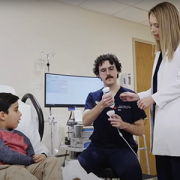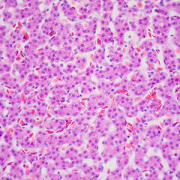Two-stage orchiopexy: making sure families follow through

Sometime in the third trimester of pregnancy, a male fetus’ testes migrate from where they formed, in the abdomen, to where they’ll reside for the rest of his life, in the scrotum. In some baby boys, the testes take some additional time to make this journey, descending sometime before 6 months of age. But 5% of term male births will have an undescended testis (up to 30% in preterm boys), necessitating surgery to get them in the right place.
For testes that are in the abdomen, the surgical approach with the highest likelihood of moving the testis into the scrotal position without loss of the testis is a two stage, laparoscopic approach, explains Tanya Davis, M.D., a pediatric urologist at Children’s National Health System. First, surgeons divide the blood supply for the undescended testicle, clipping some vessels that are too short to extend to the scrotum and sparing others. After waiting four to six months to give these spared vessels time to grow and develop further, they perform a second procedure that repositions the testicle in the scrotum.
“Doing an orchiopexy in two parts is much less traumatic for the testicle,” Dr. Davis explains. “It significantly improves the chances that the testicle will end up with enough oxygenated blood to survive the procedure.”
“This surgery is pivotal for fertility – unless the testes are correctly positioned, they won’t develop normally to produce viable sperm. Proper placement is important for testis cancer screening in the future. Testes that are undescended have a higher risk of testis cancer and are unable to be easily screened for developing cancers since they can’t be examined,” Dr. Davis says.
But she and her colleagues – H. Gil Rushton, M.D., division chief of urology at Children’s National, and resident Campbell Grant, M.D., who will be a pediatric urology fellow at Cincinnati Children’s starting this summer – suspected that not everyone who received the first part of this procedure was completing the process.
“It felt like we were doing more of the first stage than the second stage,” Dr. Davis says. “We wanted to see whether what we suspected anecdotally was actually true.”
To investigate that question, the three researchers gathered medical records from all patients at Children’s who had the two-stage laparoscopic orchiopexy procedure over the past decade – 105 in all. They then looked to see who didn’t undergo the second stage, the length of the time interval between the two stages for those who’d had both parts, and whether there were any risk factors to taking longer than recommended to have the second stage or missing it altogether. They also planned to “recapture” any patients who never had the second stage to schedule it – a pivotal step toward not only preserving fertility and improving the ability to detect testis cancer in the future, but for making sure they didn’t receive the invasive first part of the procedure for nothing.
Their results, presented at George Washington University’s GW Research Days and Children’s National annual Research & Education Week, showed that the vast majority of patients seem to receiving both parts of two-stage laparoscopic orchiopexy at Children’s National: Only four of the 105 patients didn’t receive the second stage. “Three of those were lost to follow-up completely”, says Dr. Davis, “but they were able to recapture one patient, whose parents had been concerned about exposure to anesthesia twice – valuable insight for counseling other patients in the future on options for this procedure.”
In addition, while they found that most patients received the second stage during the recommended four-to-six month window after the first stage, a fraction went beyond that timeframe. According to Dr. Davis, the older age of the patient was the most significant risk factor for waiting too long.
“When a child is older, you might have to coordinate surgery around his school schedule or activities that affect the rest of the family, a concern that’s probably not as pressing for those who get this surgery done when their children are infants,” she adds.
The study has prompted Dr. Davis and her colleagues to institute a protocol to routinely contact patients three months after their first surgery to remind them to get their second procedure scheduled. In the meantime, she says, it’s a relief that fewer patients are missing the second stage than they’d suspected.
“We were happy to be wrong,” Dr. Davis says. “It shows that we’re doing a good job in terms of counseling patients to understand what’s wrong and what they need to do to correctly complete their course of treatment.”











